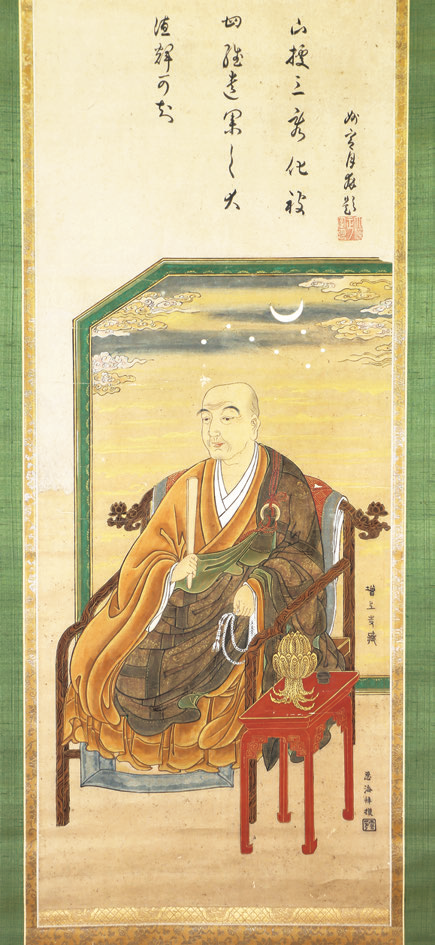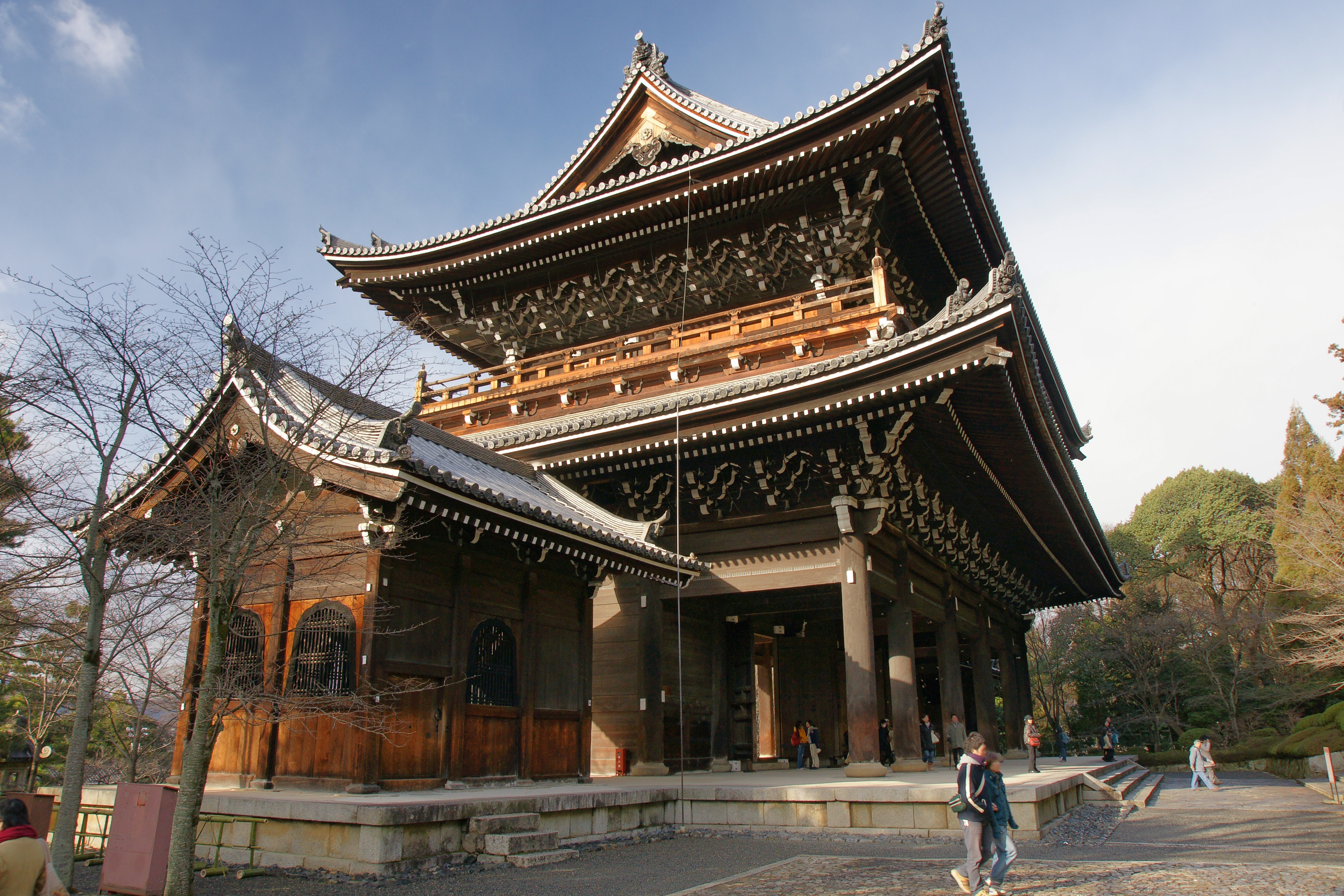|
Shōgei
Shōgei (聖冏, October 15, 1341 - September 27, 1420) was a Bhikkhu, Buddhist monk from the middle of the Muromachi period. He is the considered the seventh founder of Jōdo-shū (Chinzei, Chinzei-ha). He was a native of Hitachi Province and the Shiio clan. He entered the priesthood under Ryoji at Uriren Jofukuji Temple and studied under Rensho at Ota Honen-ji Temple in the same province. He studied a wide range of Buddhism, primarily Jōdo-shū, Pure Land Buddhism, but also Tendai, Shingon Buddhism, Esoteric Buddhism, Zen, and Kusha-shū, Kusha. He established rituals for transmission of the Buddhism, Dharma for the training of Jōdo-sect followers, formally establishing Jōdo-shū as an independent sect from Tendai. He was also well-versed in Shinto, Confucianism, and Japanese poetry. His disciples included Seisō and Ryōchi, and together with Seisō, who became the eighth patriarch of the sect, he is regarded as the leader who promoted the Jōdo sect's Chinzeigyō from a doct ... [...More Info...] [...Related Items...] OR: [Wikipedia] [Google] [Baidu] |
Chinzei
The branch, also called the Chinzei Doctrine (鎮西義), is one of the two largest branches of Jōdo-shū Buddhism (the second being Seizan). The tradition traces itself to Benchō (a.k.a. Shōkō Shōnin), a disciple of Hōnen, but it was formally established as a separate branch by Benchō's disciple Ryōchū (良忠, 1199–1287). It is also sometimes called the Chikushi school due to its early development in the Chikushi region of Kyushu. It played a key role in shaping the doctrinal and institutional framework of Jōdo-shū, which remains one of Japan's major Buddhist traditions today. Originally based in Kyushu where Benchō had been exiled, the sect contended with other disciples of Hōnen until it emerged into the dominant branch today. Its origins in Kyushu are also the reason for the sect's name, as ''Chinzei'' was an older name for Kyushu and was adopted by Benchō. The famous temple of Chion-in, Hōnen's gravesite, and the temple of Zōjō-ji in Tokyo are ... [...More Info...] [...Related Items...] OR: [Wikipedia] [Google] [Baidu] |
Jōdo-shū
Jōdo-shū (浄土宗, "The Pure Land School"), is a Japanese branch of Pure Land Buddhism derived from the teachings of the Kamakura era monk Hōnen (1133–1212). The school is traditionally considered as having been established in 1175 and is the most widely practiced branch of Buddhism in Japan, along with Jōdo Shinshū. There are various branches of Jōdo-shū, which the largest and most influential ones being Chinzei-ha and Seizan-ha. Jōdo-shū Buddhism focuses exclusively on devotion to Amitābha Buddha (Amida Nyorai), and its practice is focused on the Nembutsu (recitation of Amitābha’s name). As in other forms of Pure Land Buddhism, adherents believe that the faithful recitation of the phrase " Namu Amida Butsu" (Homage to Amida Buddha) results in birth in the pure land of Sukhavati. The Jōdo-shū as an independent sect is not to be confused with the term "Jōdo Tradition" (Jōdo-kei, 浄土系) which is used as a classification for "Japanese Pure Land Buddhi ... [...More Info...] [...Related Items...] OR: [Wikipedia] [Google] [Baidu] |
Jōdo-shū Buddhist Priests
Jōdo-shū (浄土宗, "The Pure Land School"), is a Japanese branch of Pure Land Buddhism derived from the teachings of the Kamakura era monk Hōnen (1133–1212). The school is traditionally considered as having been established in 1175 and is the most widely practiced branch of Buddhism in Japan, along with Jōdo Shinshū. There are various branches of Jōdo-shū, which the largest and most influential ones being Chinzei-ha and Seizan-ha. Jōdo-shū Buddhism focuses exclusively on devotion to Amitābha Buddha (Amida Nyorai), and its practice is focused on the Nembutsu (recitation of Amitābha’s name). As in other forms of Pure Land Buddhism, adherents believe that the faithful recitation of the phrase " Namu Amida Butsu" (Homage to Amida Buddha) results in birth in the pure land of Sukhavati. The Jōdo-shū as an independent sect is not to be confused with the term "Jōdo Tradition" (Jōdo-kei, 浄土系) which is used as a classification for "Japanese Pure Land Buddhism ... [...More Info...] [...Related Items...] OR: [Wikipedia] [Google] [Baidu] |
Confucianism
Confucianism, also known as Ruism or Ru classicism, is a system of thought and behavior originating in ancient China, and is variously described as a tradition, philosophy, Religious Confucianism, religion, theory of government, or way of life. Founded by Confucius in the Hundred Schools of Thought era (c. 500 BCE), Confucianism integrates philosophy, ethics, and social governance, with a core focus on virtue, Harmonious Society, social harmony, and Filial piety, familial responsibility. Confucianism emphasizes virtue through self-cultivation and communal effort. Key virtues include ''Ren (philosophy), ren'' (benevolence), ''Yi (philosophy), yi'' (righteousness), ''Li (Confucianism), li'' (propriety), ''Wisdom, zhi'' (wisdom), and ''Xin (virtue), xin'' (sincerity). These values, deeply tied to the notion of ''tian'' (heaven), present a worldview where human relationships and social order are manifestations of sacred moral principles.. While Confucianism does not emphasize an ... [...More Info...] [...Related Items...] OR: [Wikipedia] [Google] [Baidu] |
Japanese Buddhist Clergy
Japanese may refer to: * Something from or related to Japan, an island country in East Asia * Japanese language, spoken mainly in Japan * Japanese people, the ethnic group that identifies with Japan through ancestry or culture ** Japanese diaspora, Japanese emigrants and their descendants around the world * Japanese citizens, nationals of Japan under Japanese nationality law ** Foreign-born Japanese, naturalized citizens of Japan * Japanese writing system, consisting of kanji and kana * Japanese cuisine, the food and food culture of Japan See also * List of Japanese people * * Japonica (other) * Japanese studies , sometimes known as Japanology in Europe, is a sub-field of area studies or East Asian studies involved in social sciences and humanities research on Japan. It incorporates fields such as the study of Japanese language, history, culture, litera ... {{disambiguation Language and nationality disambiguation pages ... [...More Info...] [...Related Items...] OR: [Wikipedia] [Google] [Baidu] |
Koishikawa
is a district of Bunkyo, Tokyo. It consists of five sub-areas, . In Koishikawa are located two well regarded gardens: the Koishikawa Botanical Garden (operated by the University of Tokyo) in Hakusan, and the Koishikawa Korakuen Garden in Kōraku. Train stations for accessing this locality include , , , and Myōgadani Station. The Koishikawa Arsenal was an important military installation during the Meiji era. Education Bunkyo operates the local public elementary and middle schools. Zoned elementary schools are: Kanatomi ( 金富小学校), Kubomachi ( 窪町小学校), Rekisen ( 礫川小学校), and Yanagicho ( 柳町小学校). Zoned junior high schools are: No. 1 ( 第一中学校), No. 3 ( 第三中学校), and Meidai ( 茗台中学校). Koishikawa High School is operated by the Tokyo Metropolitan Government Board of Education. In addition the metropolis operates the Koishikawa Secondary Education School. Image:Koishikawastreets.JPG, Residential street in Koish ... [...More Info...] [...Related Items...] OR: [Wikipedia] [Google] [Baidu] |
Japanese Poetry
Japanese poetry is poetry typical of Japan, or written, spoken, or chanted in the Japanese language, which includes Old Japanese, Early Middle Japanese, Late Middle Japanese, and Modern Japanese, as well as poetry in Japan which was written in the Chinese language or ''ryūka'' from the Okinawa Islands: it is possible to make a more accurate distinction between Japanese poetry written in Japan or by Japanese people in other languages versus that written in the Japanese language by speaking of Japanese-language poetry. Much of the literary record of Japanese poetry begins when Japanese poets encountered Chinese poetry during the Tang dynasty (although the Chinese classic anthology of poetry, ''Classic of Poetry, Shijing'', was well known by the literati of Japan by the 6th century). Under the influence of the Chinese poets of this era Japanese began to compose poetry in Chinese (''kanshi (poetry), kanshi''); and, as part of this tradition, poetry in Japan tended to be intimately ass ... [...More Info...] [...Related Items...] OR: [Wikipedia] [Google] [Baidu] |
Buddhism
Buddhism, also known as Buddhadharma and Dharmavinaya, is an Indian religion and List of philosophies, philosophical tradition based on Pre-sectarian Buddhism, teachings attributed to the Buddha, a wandering teacher who lived in the 6th or 5th century Before the Common Era, BCE. It is the Major religious groups, world's fourth-largest religion, with about 500 million followers, known as Buddhists, who comprise four percent of the global population. It arose in the eastern Gangetic plain as a movement in the 5th century BCE, and gradually spread throughout much of Asia. Buddhism has subsequently played a major role in Asian culture and spirituality, eventually spreading to Western world, the West in the 20th century. According to tradition, the Buddha instructed his followers in a path of bhavana, development which leads to Enlightenment in Buddhism, awakening and moksha, full liberation from ''Duḥkha, dukkha'' (). He regarded this path as a Middle Way between extremes su ... [...More Info...] [...Related Items...] OR: [Wikipedia] [Google] [Baidu] |
Shinto
, also called Shintoism, is a religion originating in Japan. Classified as an East Asian religions, East Asian religion by Religious studies, scholars of religion, it is often regarded by its practitioners as Japan's indigenous religion and as a nature religion. Scholars sometimes call its practitioners ''Shintoists'', although adherents rarely use that term themselves. With no central authority in control of Shinto, there is much diversity of belief and practice evident among practitioners. A polytheism, polytheistic and animism, animistic religion, Shinto revolves around supernatural entities called the (神). The are believed to inhabit all things, including forces of nature and prominent landscape locations. The are worshipped at household shrines, family shrines, and Shinto shrine, ''jinja'' public shrines. The latter are staffed by priests, known as , who oversee offerings of food and drink to the specific enshrined at that location. This is done to cultivate harmony ... [...More Info...] [...Related Items...] OR: [Wikipedia] [Google] [Baidu] |
Bhikkhu
A ''bhikkhu'' (, ) is an ordained male in Buddhist monasticism. Male, and female monastics (''bhikkhunī''), are members of the Sangha (Buddhist community). The lives of all Buddhist monastics are governed by a set of rules called the pratimokṣa, prātimokṣa or pāṭimokkha, pātimokkha. Their lifestyles are shaped to support their spiritual practice: to live a simple and meditative life and attain Nirvana (Buddhism), nirvana. A person under the age of 20 cannot be ordained as a bhikkhu or bhikkhuni but can be ordained as a samanera, śrāmaṇera or śrāmaṇērī. Definition ''Bhikkhu'' literally means "begging, beggar" or "one who lives by dāna, alms". The historical Buddha, Gautama Buddha, Prince Siddhartha, having abandoned a life of pleasure and status, lived as an alms mendicant as part of his śramaṇa lifestyle. Those of his more serious students who renounced their lives as householders and came to study full-time under his supervision also adopted this lifest ... [...More Info...] [...Related Items...] OR: [Wikipedia] [Google] [Baidu] |







